I’ve asked Marc Hartung, professional massage therapist on Maui, to share his experience, as the lead massage director at the recent Naish Paddle Board and SUP Championships on Maui, July 18, 2010. All the tables were full as his team provided over 50 of the competitors a soothing post-event massage. Also read his special note on pre event massage.
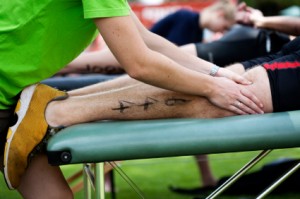
Getting a sports massage can make a huge difference post event or race!
Stand up paddling does have its own over use and injury list. Common among them are strains to the shoulder complex and rotator cuff muscles. I too suffer from a worn out supraspinatus and infraspinatus weakness that I had Marc attend to for me the next day after the muscles calmed down a bit. I had pain and numbness radiating down my shoulder like Marc describes in other competitors that checked in.
As a stand up paddler himself, his knowledge of the muscle groups that function together that allow for normal paddling efficiencies is very key in addressing one’s complaints and soreness.
Read more from Marc and learn more about how his tips and information may help you.
Marc writes:
This past Sunday I supervised a group of students from The Maui School of Therapeutic Massage, providing post event massage for competitors in the 2010 Naish standup paddleboard race. I personal only worked on two people, while I managed and screened the crowd of competitors waiting for massage, making sure they were rinsed off and well hydrated before they got on the table.
The two competitors I had the pleasure of working with were brought to my attention by some of the students. One complained of a burning sensation radiating from his elbow up to his shoulder and down to his hand, and the other, with numbness radiating down from his shoulder through his pinky finger. These can be common nerve entrapment injuries with chronic tension and overuse of certain muscle groups. When addressed early they can often be quickly relieved and eliminated with massage.
Stand up paddling works a lot of muscles and is well known for being a great core workout. It also requires a lot of work from stabilizers of the shoulder girdle. The paddle stroke is a combination of medial rotation and abduction (of the top hand). This requires the work of subscapularis, latissimus dorsi, pec. minor, pec. major, and teres major along with deltoid and supraspinatus to lift the arm up. The bottom hand is mostly stabilizing to transfer the rotation of the trunk to the paddle the muscles used to stabilize are mainly latissimus dorsi rhomboids, triceps, and middle fibers of the traps. (For more information on the anatomy of the shoulder click here:) https://www.eorthopod.com/content/shoulder-anatomy
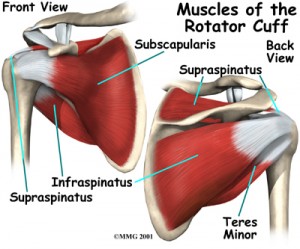
Muscles of the rotator cuff
I have found with my clients that massage is crucial in preventing nerve entrapment or overuse injuries, as well as speeding recovery from training and competing. The sooner you address tension or injuries the easier and faster they respond, allowing you to build strength with out developing tension or muscle imbalance.
A special note about “pre race” massage:
Pre event massage can happen as soon as 24 hours before the event to as close as during or following your warm up for the event.
Athletes are all particular about there preparation, some like to be relaxed some prefer a level of mental stress or “psych”, along with warming up some athletes like to keep there muscles tight and some like to stretch out and be real loose, and sometimes a bit of both in varying muscle groups. It can change drastically with different activities and especially between athletes.
With all that in consideration there are many benefits to pre race massage. A massage can help reduce anxiety (anxiety and stress alone can ruin performance). Massage can also help warm muscles and be included in your warm up routine to help prevent injury. Massage can either help to stretch and lengthen muscles or not depending on preference. Massage can can also stimulate increased motor neuron activity for faster and stronger contraction of muscles. Just make sure your massage therapist is aware of your goals and needs.
Clay Everline, M.D. of Waves of Health writes:
Rotator Cuff Strain and Impingement
A rotator cuff injury is a strain or tear in the group of tendons and muscles that hold your shoulder joint together and help move your shoulder. It is exacerbated by use of your shoulder in sports with a repetitive overhead movement, such as swimming, baseball (mainly pitchers), football, tennis and SUP, which gradually strains the tendon. Poor shoulder posture compounds this problem. Avoid flexing the shoulder overhead when initiating the SUP stroke. Make sure to be even and symmtric through the strokes.
Ice massage and perform these exercises to rehab the shoulder: For more helpful information on tips on how to strengthen your rotator cuff muscles from Clay.. click here: https://www.everlinemd.com/SUP_Medicine.html
Suzie Cooney, CPT Suzie Trains Maui

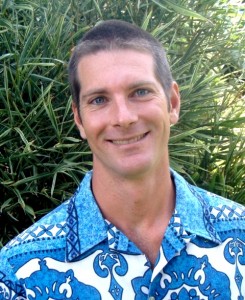
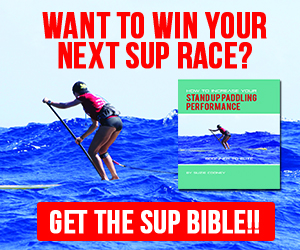
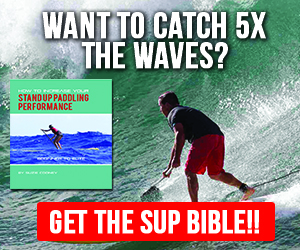
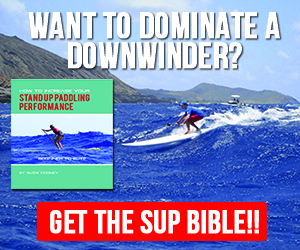
As someone who participated in that race and hasn’t sup’ed for very long, I was bound to be very sore the next day. Lucky for me, someone told me I could get a massage from Marc and his team of students. I got a great massage and I wasn’t sore the next day.
Thanks Marc for being there for every one and keeping us pain free!
Thanks Simone for sharing your experience! Glad it helped!
Suzie Cooney, Suzie Trains Maui